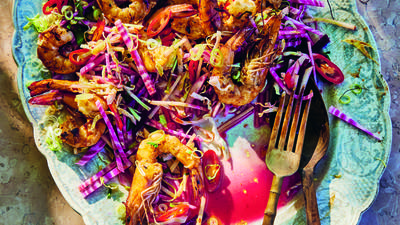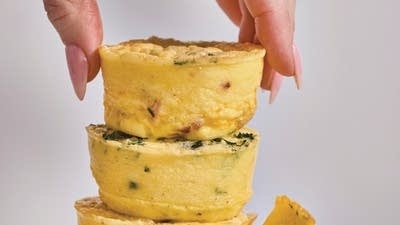
Goat can be so good, but it’s such a hard sell. It’s sustainable and delicious -- if you know what you’re doing.
Knowing what you’re doing is where Jesse Griffiths comes in. In his hometown of Austin, Texas, Griffiths is famous for his Dai Due Butcher Shop at the farmers market and for his book, Afield: A Chef’s Guide to Preparing and Cooking Wild Game and Fish. He teaches hunting for the table and how to handle all kinds of local meats -- right now he’s teaching a class on goat.
Lynne Rossetto Kasper: I’ve heard for a long time that goat is the next big thing. Do you think its time has arrived?
 Jesse Griffiths
Jesse Griffiths
Jesse Griffiths: Absolutely. The time arrived a long time ago around the world for goat. It’s an incredibly popular meat; beyond chicken it’s the most-consumed meat in the world and it is the most-consumed red meat in the world because of its ability to thrive in pretty much any environment. I think people are coming around to that again especially in this country. They’re starting to realize it is a very valid food source.
LRK: What does it taste like? If you’ve never had it, how do you describe it?
JG: It tastes sweeter than lamb, more delicate. It definitely has its own flavor, obviously. As with any animal, there’s a current that runs through it; there’s always a flavor that’s there. If you’ve ever had goat cheese and then you eat goat, there is a bit of similarity there. Just like if you eat sheep milk cheese and lamb, there will be that slightly acidic note. It’s kind of hard to describe.
LRK: It’s almost like a grassy-but-slightly-acidic quality, that’s what it reminds me of. There are new names now -- I think one name now is chevon.
JG: Yes, that’s one that is a slightly older goat; I think up to 1 1/2 years. The equivalent of lamb is the cabrito, which is very popular in northern Mexico and southern Texas.
LRK: You work with a particular farm usually -- you like to use their goats in your classes. What do we have to know about goat to buy it?
JG: Definitely the source of it. That’s a big part of everything that we do -- just know your source. We’re very picky and we really like our producer, Windy Hill Organics out in Comanche, Texas. It’s the way he raises them: They’re raised on alfalfa, then they forage naturally, and he harvests at appropriate sizes and ages. We can get true cabrito from him, which is in the 15- to 20-pound range, and then the larger chevon without them getting too big, where the flavor becomes a little more assertive. Of course as the animal gets older, the flavor will become more pronounced. Cabrito I think is very accessible; if people have never had anything like it, it’s quite, quite good.
LRK: Where should we be buying our goat? Should we be going to halal markets because it’s used so much in those cultures? Should we be in Mexican or Latin American places? Or should we be going to farmers markets?
 Afield: A Chef’s Guide to Preparing and Cooking Wild Game and Fish
Afield: A Chef’s Guide to Preparing and Cooking Wild Game and Fish
JG: Your first stop should be the farmers market because you’re going to be dealing directly with the producer and you’ll be able to ask questions: Do these live outdoors? What were they fed? How old was the animal? You can get a good sense of the person that’s raising them and that should tell you a lot about how that food is going to be.
But beyond that, a halal market, a Central American market or a Mexican market will all likely have goat. That goat will likely have come from Texas as well. We raise about 70 percent of the domestic market of goat here in this state just because it is so well-suited for goats -- or maybe poorly suited for other animals. They can live in pretty harsh environments, so we raise a lot of them here. I always urge people to know your source, but beyond that, just go to a market, ask some questions and just experiment.
LRK: What are some of the tricks to know when you’re cooking goat?
 Grilled Goat Chops with Garlic, Oregano and Lemon
Grilled Goat Chops with Garlic, Oregano and Lemon
JG: The less exercised cuts of any animal -- like the loin, which is where the chops are, and the tenderloin -- will need to be cooked very quickly. There’s not a lot of connective tissue that’s going to break down over a long period of time, so they’re going to need to be cooked quickly, typically at high heats like on a grill or a quick sear in a pan where the meat is still left at medium, maybe even medium-rare. It’s perfectly alright to cook goat up to medium-rare just like you would lamb. The other cuts -- the shoulder, the shanks, legs -- will need to be long-cooked, maybe smoked, maybe braised, maybe pot-roasted.
Basically the same techniques you would apply to any meat will apply to goat. I highly recommend just using a lot of the same spices, seasonings and herbs because they tend to marry very well. Mint, for example, is beautiful with goat, and spices like cumin and caraway.
Before you go...
Each week, The Splendid Table brings you stories that expand your world view, inspire you to try something new, and show how food connects us all. We rely on your generous support. For as little as $5 a month, you can have a lasting impact on The Splendid Table. And, when you donate, you’ll join a community of like-minded individuals who love good food, good conversation, and kitchen companionship. Show your love for The Splendid Table with a gift today.
Thank you for your support.
Donate today for as little as $5.00 a month. Your gift only takes a few minutes and has a lasting impact on The Splendid Table and you'll be welcomed into The Splendid Table Co-op.




